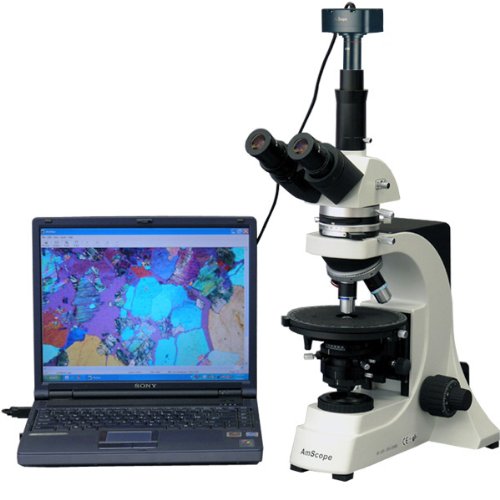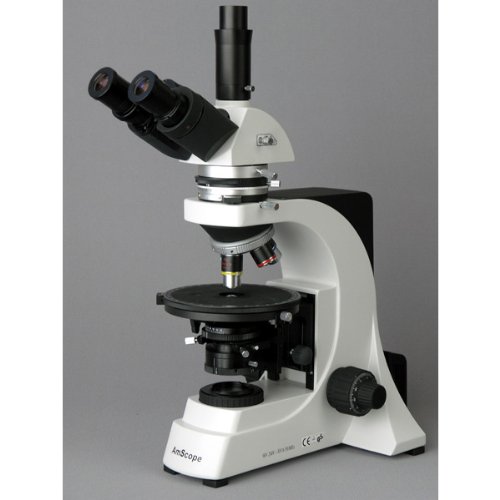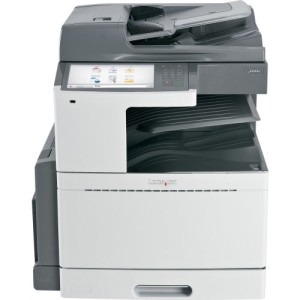Description
The AmScope PZ300TB-MT digital compound trinocular polarizing microscope has interchangeable pairs of 10x22mm (one with reticle) and 20x12mm extreme widefield infinity plan high eye-point eyepieces, a focusable Bertrand lens on a rotatable disc, a reverse-mounted quadruple nosepiece with four strain-free DIN achromatic objectives, polarizing and Brightfield 30W halogen illumination, and a round graduated stage with a stage stop to offer protection to slides and objectives from damage. The 1.3MP camera has a CMOS color sensor, a reduction lens, image capture and editing software, and USB 2.0 output to capture or display still or video images on a pc or projector. The microscope has a color-corrected infinity optical system (CCIS) that provides color correction and improved focal point of the intermediate image across all the focal plane. The trinocular head has a Siedentopf binocular mount with interchangeable pairs of super-widefield PL10x22mm (one with reticle) and PL20x12mm infinity plan high eye-point eyepieces, 50 to 80mm interpupillary adjustment, a fixed 30-degree vertical inclination to reduce eye and neck strain, and a 360-degree rotation capability to enable sharing. A Siedentopf binocular head enables the viewer to change the interpupillary distance without changing the tube length, getting rid of the want to re-focal point the image. High eye-point objectives ease viewing for users who wear glasses, and dioptric adjustment contains individual eye-strength differences. A reticle enables users to specify the location of areas of interest. The vertical trinocular port can be utilized as a C-Mount or 23mm photo port (camera sold one after the other). The reverse-mounted, ball-bearing driven quadruple nosepiece has 4x, 10x, 40xS(spring), and 60xS DIN strain-free infinity plan achromatic objectives that provide focal point over all the range of the viewing field, and a longer working distance for improved focal point when auxiliary components are utilized. Strain-free objectives are optimized to be used with polarized light. The 40xS and 60xS objectives are spring loaded to prevent slide damage when focusing. A reverse-mounted nosepiece helps to keep objectives out of the right way to prevent damage and contamination, and to enable more protected slide handling. Polarizing microscopes are used in geology, petrology, mineralogy, toxicology, pharmacology, forensics, and industrial inspection applications to view and measure birefringence of anisotropic materials, including organic compounds, water, minerals, and rocks.
The 1.3MP digital camera has a CMOS color sensor for displaying still microscopy images and streaming live videos to a pc or projector. The camera has 40x magnification and a built-in 0.5x reduction lens that ensures that the display has a an identical field of view as the microscope eyepiece. The camera can also be mounted in a C/CS-Mount or any 23mm eye tube. The camera includes image capture and editing software that provides still image and live video capture and editing. Measurement functions include length, area, and angle. The software supports JPEG, BMP, TIFF and RAW, and is compatible with Windows (32- and 64-bit XP, Vista, 7, and 8), and Mac OS X (32-bit). Camera drivers are compatible with Windows (XP, Vista, 7, and 8), Mac OS X, and Linux. The camera has a USB 2.0 data port (cable included).
The microscope has polarizing and Brightfield illumination with a selection knob to choose from illumination types. The built-in Bertrand lens has a rotating disc with centering controls, and 90-degree rotation with 1-degree graduations. The polarizer, analyzer, and Bertrand lens can also be got rid of from the optical path to make use of the microscope as a Brightfield microscope. Transmitted 30W halogen illumination has a rheostat to regulate light intensity, and provides bright light in a concentrated path. The Kohler condenser focuses and centers the light path the use of two iris diaphragms, providing optimum contrast and resolution. The round 160mm diameter floating stage has 360-degree rotation on a ball-bearing movement, and a 28mm vertical go back and forth range. The stage is graduated in 1-degree increments and is equipped with a vernier scale for greater precision, which allows retardation measurements to be made with a minimum resolution of 6 minutes of arc. It has a locking screw to protected the stage location, detachable slide clips, and a stain-resistant finish. Nested coaxial coarse and fine focal point has tension-adjustable coarse focusing and an adjustable lock ring stopper that limits stage range to offer protection to slides and objectives from damage. All-metal mechanical parts, solid-metal frame construction, and a stain-resistant enamel finish provide durability.
| Microscope Specifications | |
|---|---|
| Head | Trinocular |
| Magnification range | 40x-1200x |
| Eyepieces (30mm) | PL10x22mm, PL10x22mm with reticle, PL20x12mm |
| Objectives (20mm) | Strain-free 4x, 10x, 40xS, and 60xS DIN infinity plan achromatic polarizing |
| Stage | Round mechanical, with 1-degree increments and 6′ (minutes of arc) vernier graduations |
| Condenser | Kohler |
| Midist head | 160mm diameter, built-in removable analyzer, 90-degree rotation with 6′ (minutes of arc) vernier |
| Light source | Halogen with rheostat, 6V/30W |
| Illumination type | Polarizing/Brightfield |
| Power | 90V to 240V |
| Camera Specifications | |
|---|---|
| Resolution | 1.3MP (1280 x 1024 effective pixels) |
| Image type | Still image and video display and capture |
| Camera type | Brightfield |
| Camera sensor | 1/3″ Color CMOS (Micron) |
| Magnification | 40x (20x with reduction lens) |
| Reduction lens | 0.5x (built-in) |
| Mounting size | 23mm or C/CS-Mount |
| Frame rate | 30 fps at 640 x 480; 15 fps at 1280 x 1024 |
| Computer connection | USB 2.0 |
| File formats | JPG, BMP, TIF and RAW |
| Software package | Image capture and editing for Windows XP, Vista, 7, and 8 (32 & 64bit); and MAC OS X (32-bit) |
| Camera driver compatibility | Windows XP, Vista, 7, and 8; Mac OS X; and Linux |
Microscopes are instruments used to make stronger the resolution of an object or image. Types include compound, stereo, or digital. Compound microscopes use a compound optical system with an objective lens and an eyepiece. Stereo microscopes show object depth in a three-dimensional image. Digital microscopes are used to display an image on a monitor, relatively than taking a look through a lens. Microscopes can have monocular (one), binocular (two), or trinocular (three) eyepieces, with varying magnification abilities. Magnification ability refers back to the size of an image. Resolution, sometimes called resolvant power, refers back to the clarity of the image. The interaction between field of view (FOV), numerical aperture (NA), and working distance (WD) determines resolution. Microscopes can regulate magnification through a fixed focal point, or through a range of adjustments. They are able to also utilize LED, fluorescent, and mirror light sources to lend a hand regulate viewing capabilities. Microscopes are widely used in education, lab research, biology, metallurgy, engineering, chemistry, manufacturing, and within the medical, forensic science, and veterinary industries.
United Scope manufactures microscopy equipment and accessories under the brand name AmScope. The company, founded in 1996, is headquartered in Irvine, CA.
What’s within the Box?
- AmScope PZ300TB-MT microscope
- PL10x22mm high eye-point plan eyepiece, 30mm
- PL10x22mm high eye-point plan eyepiece, with reticle, 30mm
- PL20x12mm high eye-point plan eyepiece, 30mm, one pair
- 4x DIN strain-free infinity plan achromatic objective, 20mm
- 10x DIN strain-free infinity plan achromatic objective, 20mm
- 40xS DIN strain-free infinity plan achromatic objective, 20mm
- 60xS DIN strain-free infinity plan achromatic objective, 20mm
- Polarizer
- (2) Color filters; blue and green
- 1.3MP digital camera with built-in reduction lens (MT130)
- USB 2.0 cable
- Software CD
- (2) Spare halogen bulbs
- (2) Spare fuses
- Power cord
- Dust cover
- Instructions
Polarizing compound microscope has a built-in focusable Bertrand lens on rotatable disc to be used in geology, petrology, mineralogy, toxicology, pharmacology, forensics, and silicon wafer and industrial inspection applications, and a 1.3MP camera with reduction lens and USB 2.0 output for capturing or displaying images on a pc or projector
Siedentopf trinocular mount with interchangeable pairs of 10x22mm (one with reticle) and 20x12mm super-widefield plan high-eye point eyepieces, 50 to 80mm interpupillary adjustment, fixed 30-degree vertical inclination to reduce eye and neck strain, and 360-degree rotation capability to enable sharing
Color-corrected infinity optical system (CCIS) with reverse-mounted quadruple nosepiece and 4x, 10x, 40xS, and 60xS strain-free infinity plan achromatic with precision-ground elements optimized to be used with polarized light
Polarizing illumination with focusable Bertrand lens on rotating disc, and Brightfield illumination with rheostat-controlled 30W halogen illumination
Round stage with 360-degree rotation, nested coaxial coarse and fine focusing system; tension-adjustable coarse focusing and lock ring stopper to limit coarse range and offer protection to slides






Reviews
There are no reviews yet.